Uncategorized
April speeds surprise to the high side
admin | May 10, 2019
This document is intended for institutional investors and is not subject to all of the independence and disclosure standards applicable to debt research reports prepared for retail investors.
MBS prepayment speeds surged past expectations in April as Fannie Mae 30-year speeds increased 25.7% to 11.2 CPR from 9.0 CPR and Freddie Mac speeds jumped 31.2% to 11.4 CPR from 8.8 CPR. Ginnie Mae II speeds followed suit, increasing 26.3% to 14.6 CPR from 11.7 CPR. Day count was unchanged and seasonal turnover doesn’t tend to increase much from March to April, yet discount speeds still jumped 20% or more. Lagged rates were roughly 13 bp lower, which pushed speeds up even faster. Newer vintages increased the most, in both conventionals and Ginnies.
There was a short, but deep, rate rally in late March. Likely many newer borrowers were able to take advantage of this short window of low rates and close their refinances in April. The average rate is deceptive since rates were not low for very long.
Exhibit 1: Prepayment speeds jumped across the stack in April
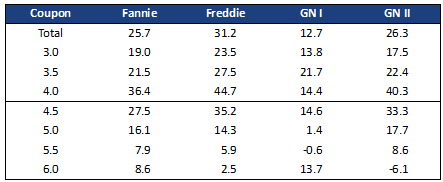
Note: % change in 30-year prepayment speeds from March 2019 to April 2019. Source: Fannie Mae, Freddie Mac, Ginnie Mae, eMBS, 1010data, Amherst Pierpont Securities
Low WAC and low loan balance pools provided prepayment protection
GSE pools with lower gross WACs generally prepaid much better than those with higher WACs. For example, many pools issued in December 2018 had very high WAC-to-coupon spreads. Fannie Mae 30-year 3.5% pools with more than 80 bp of spread prepaid at 10.5 CPR compared to 1.5 CPR for those with less than 80 bp of spread. Similarly, high spread 30-year 4.0%s prepaid at 17.3 CPR with lower spread pools at 11.8 CPR.
Low loan balance pools prepaid well even if the pools had higher WACs. For example, HLB 30-year 4.0% pools issued in December with spreads greater than 80 bp only prepaid at 4.1 CPR in April. Pay-ups remain very high for specified pools, at least in part due higher gross WAC pool production driving down the quality of the TBA deliverable, but the collateral does perform better.
New pool production should improve when UMBS goes live, since the GSEs will cap both WAC or coupon spread and the amount of servicing that can be retained. New UMBS pools should outperform the TBA, and pay-ups for low WALA pools could move higher.
The largest increases came in newer vintages
Recent vintage conventional pools performed especially badly, as many of these pools have very high spreads between the weighted average coupons (WACs) of the loans and the pool’s coupon. But even newer Ginnie pools prepaid much faster in April, and these pools don’t have high spreads. For example, Ginnie II 4.0%s 2018 increased 67.9% compared to a 73.3% increase in the same coupon Fannie MBS. Meanwhile the 2017 vintages increased 39.1% and 27.1% at Ginnie and Fannie, respectively.
Freddie pools prepay faster than Fannie MBS in April
Freddie speeds increased more than Fannie MBS, which is not something market participants wanted to see one month before the introduction of the UMBS. However the cohort-level speed differences remain well within the thresholds established by the FHFA. For example, the Fannie Mae 4.0% cohort prepaid at 13.1 CPR and the Freddie Mac cohort at 13.5 CPR. Ongoing cohort-level monitoring considers any difference less than 2.0 CPR (calculated using 3-month speeds) to be acceptable.
Looking ahead
Prepayment speeds should increase another 25% in May—lagged mortgage rates fall 11 bp on a 30-day lag, there is one additional business day, and seasonal turnover increases as school years end across much of the country. June will likely slow a little since there are two fewer business days. Speeds should rebound in July and August due to higher day count and peak housing turnover.
Data Tables
Exhibit 2: Prepayment Summary
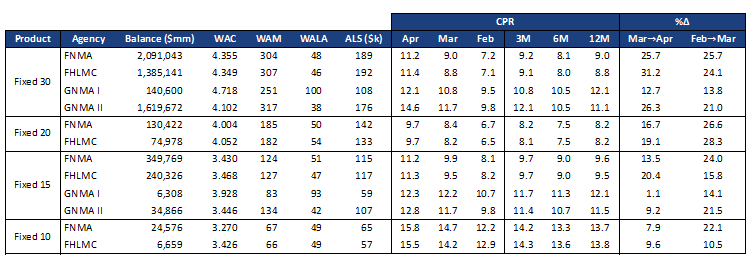
Source: Fannie Mae, Freddie Mac, Ginnie Mae, eMBS, Amherst Pierpont Securities
Our short term forecast is shown in Exhibit 5 (Fannie Mae) and Exhibit 6 (Freddie Mac). Exhibit 4 shows the static rates used in the prepayment forecast.
Exhibit 3: Agency Speeds, Largest Cohorts
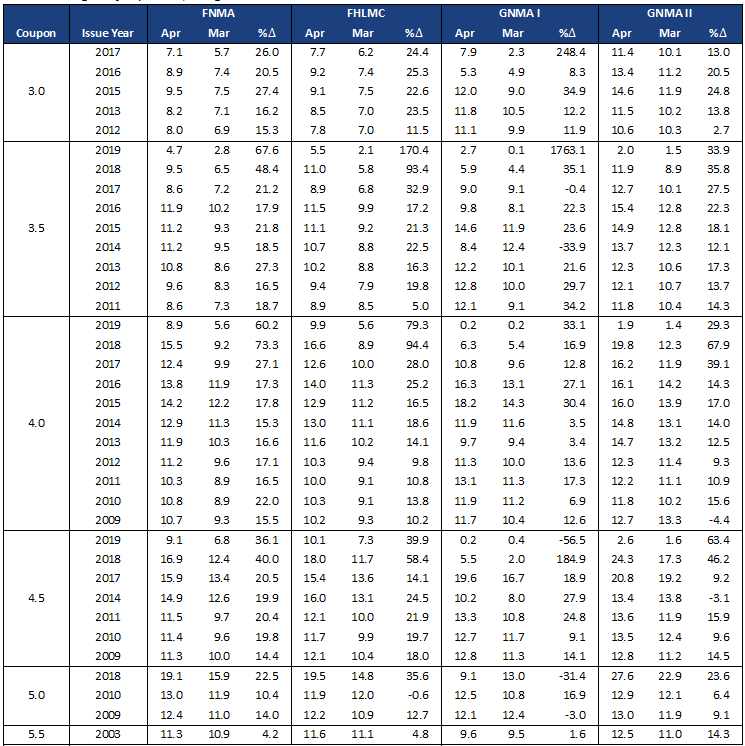
Source: Fannie Mae, Freddie Mac, Ginnie Mae, eMBS, 1010data, Amherst Pierpont Securities
Exhibit 4: Mortgage Rate Forecast

Source: Freddie Mac, Bloomberg, Amherst Pierpont Securities
Exhibit 5: Fannie Mae Short Term Forecast
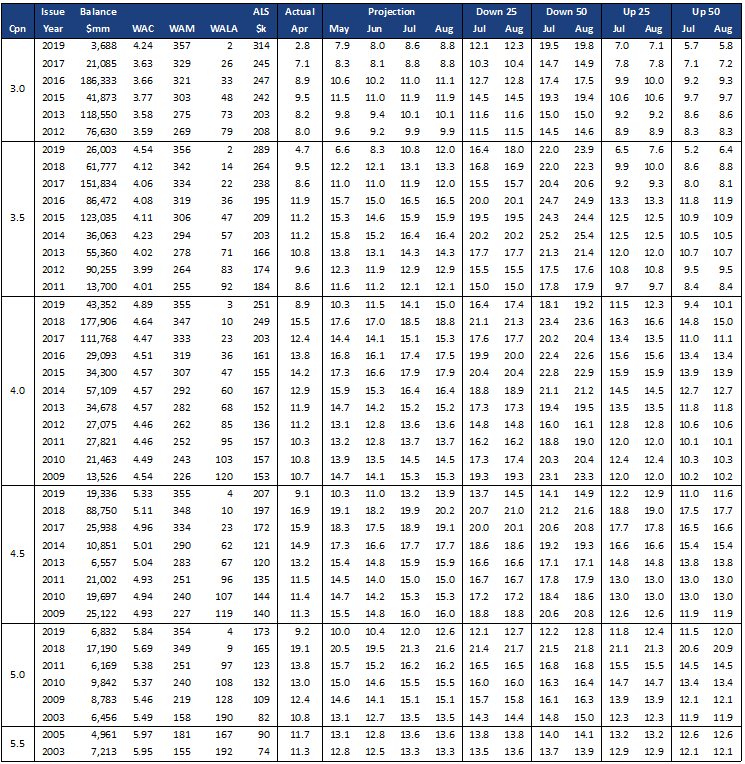
Source: Fannie Mae, eMBS, 1010data, Amherst Pierpont Securities
Exhibit 6: Freddie Mac Short Term Forecast
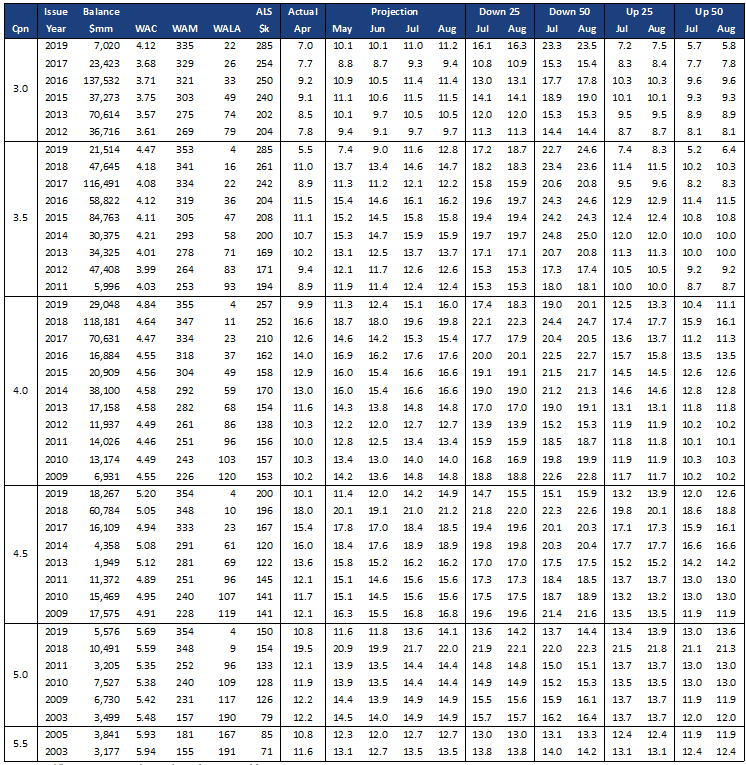
Source: Freddie Mac, eMBS, 1010data, Amherst Pierpont Securities


